Queen Anne pistol
Queen Anne pistols are a type of flintlock pistol distinguished by the lockplate being forged in one piece with the breech and the trigger plate. They are usually a breech-loading design known as a turn-off pistol. Possibly first made in England,[1] they came in fashion in England during the reign of Anne, Queen of Great Britain, hence the name. Though made in all sizes up to carbine, they were usually made in the size range known as coat pocket pistols or coat pistols, easy to conceal on one's person. A small version, known as a Toby or muff pistol, was able to be concealed in a smaller pocket or a ladies' hand warmer muff.
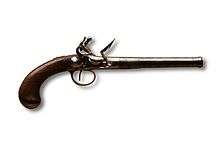
Other types of pistol are often referred to as "Queen Anne", but to hopefully improve consistency in nomenclature the term is used here only to refer the "integral breech" lock.
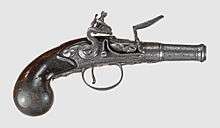
Design
Queen Anne pistols are characterized by the fact that the breech and the trigger plate are forged in one piece with the lock plate, foreshadowing by over 100 years the so-called "action" of a modern weapon. A variant, made for muzzle loading with loose shot, had the barrel integral with the breech but in the typical Queen Anne the barrel unscrews with a barrel key or wrench just ahead of the chamber where the powder and ball are placed when the pistol is loaded. The chamber is long and narrow with a cup at the top shaped to fit the bullet (a round lead ball). The user can quickly fill the chamber with black powder and put a bullet on top; the barrel is then replaced, sealing the bullet between its cup and the breech end of the barrel.
The bullet is larger than the barrel, so the breech is tapered to compress the ball as it moves forward at the moment of firing to tightly fit the bore. High gas pressure is developed behind the bullet before it is forced into the barrel, thus achieving considerably higher muzzle velocity and power than with a muzzle loader. The barrel was often rifled, which improves accuracy. The system also avoids the need for wadding or a ramrod during loading. It was not successful as a military weapon because in the heat of battle the separate barrel could be dropped during loading. A swiveled, hinged link was designed to allow the barrel to be unscrewed while still remaining attached, but this was evidently not successful. The greatest popularity of the Queen Anne was among civilians as an effective self-defense weapon. It was often highly decorated to suit the tastes of the wealthy.
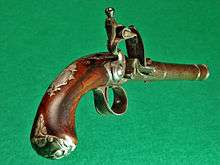
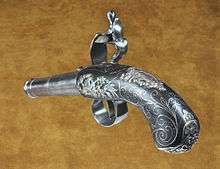
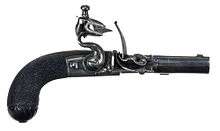
Muff pistols, boot pistols and overcoat pistols
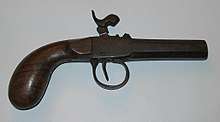
During the 18th century, wealthy travellers concealed small single shot boxlock flintlock pistols in the pocket of an overcoat or waistcoat as protection from highwaymen.[2] For the wealthiest clients, English and French gunsmiths produced a garniture comprising a fowling piece or hunting rifle, two large dueling pistols or horse pistols, and two small boxlock pistols with identical engraving on the barrel, lockplate and buttstock. These included large calibre Manstopper pistols designed for use at point-blank range, and breachloading Overcoat pistols with a turn-off barrel and sometimes a folding trigger.[3] Such weapons designed specifically for women, generally in a small caliber such as .31 due to the lower recoil, were called "muff pistols", due to their compact size enabling them to be carried in a muff.[4]
The boot pistol, a small caliber cap and ball version of the boxlock muff pistol produced from 1800 until the 1850s by various companies including Manhattan Firearms, sometimes featured an under-hammer for a faster draw.[5] These became popular among Union army officers during the American Civil War, as a backup gun which was typically used to deter surgeons from amputating the officer's limb in the event of injury.[6] This type of pistol is the ancestor of the caplock derringer used by gamblers in the Old West.[7] The small pistols were frequently used by women, because they were easily concealable in a purse or as a stocking gun.[8][9]
Sources and references
| Wikimedia Commons has media related to Queen Anne pistols. |
- Pirate Living History 1680–1725
- Burgoyne, John W., The Queen Anne Pistol. Museum Restoration Service, 2002 ISBN 0-88855-015-4
- Boothroyd, Geoffrey, The Handgun, Crown Publishers 1970
- Garrett, Richard, The Evolution of the Queen Anne Pistol. Catalogue of the London Park Lane Arms Fair, Spring 2005
Notes
- Burgoyne, John W. (2002). The Queen Anne Pistol 1660–1780. Museum Restoration Service. See pages 17–19
- Handgun safety
- Omaha Indians
- Boorman, Dean K. (1 November 2004). Guns of the Old West: An Illustrated History. Globe Pequot Press. pp. 28–35. ISBN 978-1-59228-638-6.
- Manhattan pistols
- Civil War guns
- Guns of the Old West
- Carter, Gregg Lee (1 January 2002). Guns in American Society: An Encyclopedia of History, Politics, Culture, and the Law. ABC-CLIO. p. 159. ISBN 978-1-57607-268-4.
- Guns of the Civil War